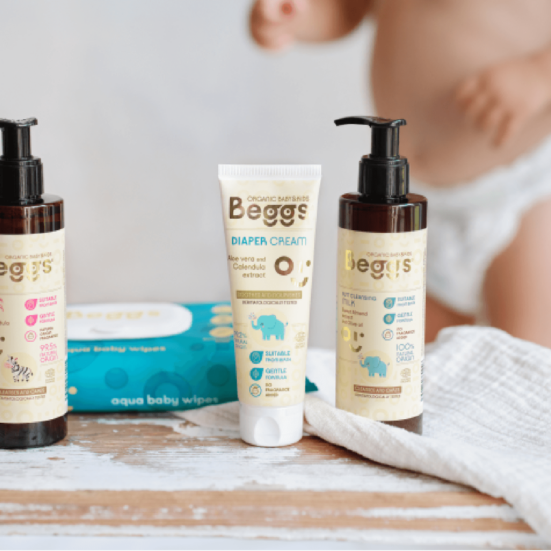It is attentive parents who set the trend in children’s nutrition. The active interest in nutrition and immunity of their offsprings motivated experts all over the world to focus attention on the intestinal microflora. Scientists have revealed that 70 to 80% of immune cells are located in the intestines and, together with the intestinal microflora, they constantly work on proper digestion and the functioning of the immune system1.
Even though the importance of intestinal microflora and its composition has become more talked about, many parents do not know the difference between probiotics and prebiotics, how they work and how to ensure their sufficient intake.
To facilitate your journey through mindful parenting, we present a quick guide to the world of probiotics and prebiotics, which was created based on an interview with a nutrition specialist.
About good bacteria
Probiotics are often referred to as “friendly” or “good” bacteria. Their regular consumption in the right amount helps to maintain the balance of good bacteria in the intestines.
Different strains of probiotics have different effects on the gut microbiota. Most of them contain bacteria from the genera Lactobacillus or Bifidobacterium. Lactobacilli are known for producing lactic acid and have been used for centuries in food processing, especially for the cultivation of dairy products. They are important colonizers of the digestive tract, mouth and vagina. Bifidobacteria are the first colonizers of children’s intestinal microflora.
Probiotics do not occur naturally in food. However, some of them are rich in live bacteria, which are created in the process of their production by fermentation. These include yogurt, kefir, kimchi, pickles, kombucha, sauerkraut, sourdough bread, miso or tempeh.
Do you know that… there are approximately 40 billion bacterial cells in the human body? Their number is up to 10x higher than the number of cells that make up the human body, which means that 90% of all cells in the body come from bacteria.
Food for microbes
Prebiotics are indigestible plant fibers and act as food for probiotics. Food sources of prebiotics include onions, garlic, bananas, oats, artichokes, asparagus, leeks, psyllium fiber, whole wheat, whole corn or chicory.
Do you know that… one of the biggest and best sources of probiotics is chicory root, which contains almost 65% fiber?
Breast milk is the first and most important prebiotic
Breast milk contains carbohydrates, proteins, fats, vitamins, water and minerals necessary to perfectly satisfy the nutritional needs of the developing organism. It is also an important source of bioactive substances. Prebiotics and probiotics in breast milk affect body functions and biological processes in the body. Their amount in breast milk changes depending on the eating habits of the mother and the needs of the child during breastfeeding.
The most important and third most abundant solid component of breast milk are oligosaccharides, which function as prebiotics. They promote the growth of good bacteria, and help in the battle between good and potentially harmful bacterias.
Interestingly, the digestive system of the baby in the womb is “sterile” and does not contain any bacteria. After birth, it is exposed to bacteria from the mother’s body and the external environment. Diet then plays a vital role in the development of beneficial bacteria. Babies who are breastfed have more bioactive substances in their intestines and are more resistant to disease than those who are given formula2.
Do you know that… babies born vaginally have a different gut microbiome than those born by C-section? Through natural birth, the baby gets most of its intestinal bacteria from its mother. Newborns after caesarean section have more bacteria in their intestines from the hospital environment3.
Synbiotics and milk nutrition
Prebiotics and probiotics have a complex effect. Together, they keep the baby’s tummy comfortable. Their joint combination is called a “synbiotic”.
Mothers who cannot breastfeed and are dependent on artificial nutrition can use preparations with probiotics and prebiotics.
Mommy’s Microbiome
The baby’s immune system begins to form already in the womb. During the first 36 months of life, it continues to develop and mature. The results of scientific studies have shown that the intestinal bacteria of pregnant and lactating women influence the microbiota of the child. For example, stress or anxiety cause a bacterial imbalance. This can cause an increase in dangerous bacteria and a decrease in friendly bacteria, which can lead to the emergence of various diseases, changes in eating habits and moods, which naturally disrupt the child’s physiological functions and emotions4.
The balanced microflora of infants regulates not only the state of immunity in early life, but also in adulthood5.
In addition to a wholesome diet, mothers should make sure they get enough sleep. At the same time, they should include exercise, deep breathing and meditation in their daily routine. These techniques will calm the mind, support fitness and bowel activity.
Do you know that…gut bacteria produce roughly 95% of the serotonin in the body. The “hormone of happiness” affects not only mood, but also the activity of the digestive tract.
Resources:
1. https://pubmed.ncbi.nlm.nih.gov/33803407/
2. https://www.ncbi.nlm.nih.gov/pmc/articles/PMC7764098/
3. https://www.sciencedaily.com/releases/2019/09/190918131447.htm
4. https://global.theprobioticsinstitute.com/en/health-areas/babies-and-young-children/probiotics-during-pregnancy
5. https://www.frontiersin.org/articles/10.3389/fimmu.2021.708472/full



